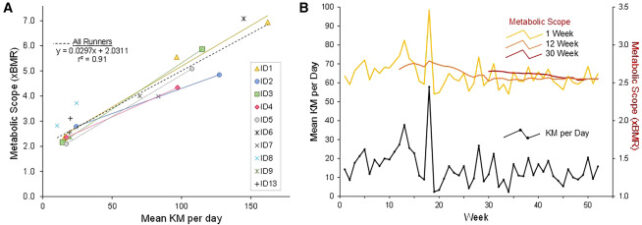Elite athletes can push their bodies to the very limit, but even they can’t surpass the boundaries of human nature, according to new research.
Scientists have found yet more evidence that, regardless of a person’s fitness or training, the human body is limited and can’t burn calories at more than 2.5 times its resting metabolic rate for long periods of time.
Exceeding this rate when training for 30-plus weeks is not impossible, but it’s rare.
Related: Croatian Freediver Shatters Record For Longest-Held Breath
Previous studies have also found a similar ‘metabolic ceiling’ to human endurance, at roughly 2.5 times the resting metabolic rate. But this new research uses a gold standard measurement for calorie burning and sampled twice as many athletes.
The analysis took place among 14 highly trained, world-class athletes, including runners, cyclists, and triathletes. Only two of the athletes were female, and most were between 30 and 44 years of age.
 frameborder=”0″ allow=”accelerometer; autoplay; clipboard-write; encrypted-media; gyroscope; picture-in-picture; web-share” referrerpolicy=”strict-origin-when-cross-origin” allowfullscreen>
frameborder=”0″ allow=”accelerometer; autoplay; clipboard-write; encrypted-media; gyroscope; picture-in-picture; web-share” referrerpolicy=”strict-origin-when-cross-origin” allowfullscreen>First, participants had their total energy expenditure calculated to see how many calories they burned with each workout and during races. Scientists had participants drink a bottle of water enriched with two metabolic tracers, levels of which could be measured in urine and used to predict how much energy was expelled during exercise.
This equation was then used to predict an individual’s maximum ‘metabolic scope’ over the course of 52 weeks, using detailed training records.
On average, the athletes in this study rarely burnt more than 4,000 calories each day. That’s 2.4 times their resting metabolic rate.

For short periods of time the athletes could surpass this rate. The highest measured metabolic scope was more than seven times the athlete’s base metabolic rate. That was measured during a nearly 24-hour run of the Appalachian Trail. A few other ultramarathoners also exceeded their base metabolic rate by more than 4-fold on certain multi-day races.
But when averaged out over the course of a year, these energetic bursts were short-lived.
The human body might be able to burn more than 2.4 times its basal metabolic rate on occasion, but after about 30 weeks of training and races, it’s unlikely to exceed an average ceiling.
Only four athletes in the study surpassed this predicted metabolic ceiling after 30 weeks or more, but they are an exception, and the difference was small. Their metabolic scope was around 2.7 times their resting rate.
“Athletes in this study did not meaningfully exceed the proposed metabolic ceiling,” the authors conclude.
“World-record ultra-endurance running performances suggest markedly higher expenditures may be possible in exceptional cases.”
But without direct measurements from a greater number of elite athletes, the barriers of human endurance remain fuzzy at best.
Growing evidence suggests there is a hard limit to the extremes of human endurance, but there’s always a chance some future athlete comes along and proves that wrong.
The study was published in Current Biology.
Source link



